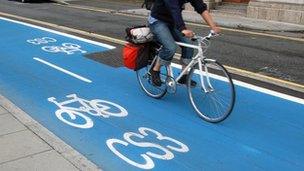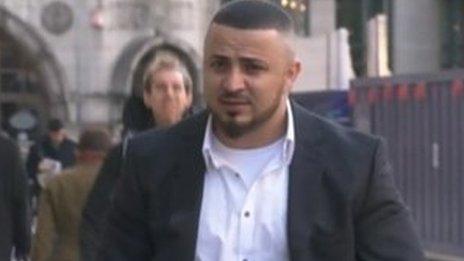Gap in the UK's law on cycling?
- Published

Official cycle routes: Often close to car parking zones
A driver opens his car door. There's a collision with a cyclist. Is this a criminal act?
On Friday, a jury at the Old Bailey took just over an hour to decide that driver Kenan Aydogdu was not guilty of the manslaughter of Sam Harding, a cyclist who died in these circumstances in August last year.
The outcome of this very unusual case raises important questions about the law and whether there is, arguably, a hole in safety legislation on Britain's roads.
Kenan Aydogdu was the first driver ever to be charged with manslaughter of a cyclist as a result of an accident. Quite simply, the police and Crown Prosecution Service believed that the evidence in the case had to go before a jury - but they had no lesser offence to put on the charge sheet.
So what exactly happened?
Sam Harding, who was 25, was cycling along one of London's busiest roads in August last year. Mr Aydogdu had parked his car up ahead, next to a bus lane which was also shared by bikes. He opened his door to get out.
What happened next was all over in a couple of seconds. Mr Harding hit the car door and was flung into the path of the bus that was following him. He went under its wheels and was crushed. On the day that Mr Harding died, he was moving in with his long-term girlfriend.
Mr Aydogdu had added a tint to his car windows which reduced the visibility to 17%. During the trial, he admitted he made a mistake by not looking in his mirror - but he insisted that he had only opened the door wide enough to turn his head and see traffic. He believed he acted safely - and the jury could not decide beyond reasonable doubt that he was guilty of a crime.
Criminal responsibility?
Police believed that Mr Aydogdu was criminally responsible for what happened - but there was no way he could face the typical offences levelled at drivers whose actions are called into question. That's because although the death involved a car, the motorist was not driving.

Mr Harding was cycling legally in a bus lane before the fatal accident
A driver cannot be charged with Causing Death by Dangerous Driving if they are not driving. In fact, offences relating to accidents caused by vehicles generally refer to its movement in some way or other.
Jorren Knibbe is a barrister and author of the UK Cycle Rules blog, external, where he writes about the rules of the road.
He says that if someone drives a car on a road and a cyclist is killed, then the motorist may obviously face a prosecution for death by dangerous driving.
"There is a question in how you define driving," says Mr Knibbe. "If someone has stopped at lights [and causes an accident], the car could still be said to be moving and so there would be an argument for an offence there.
"If the car was not moving, and the driver had just been getting in or out, it is less clear."
There is a specific offence of opening a car door so as to cause an accident - as explained on Mr Knibbe's blog, external.
But this offence is very minor. It is dealt with by magistrates, the lowest criminal court, and their powers are limited to a fine. The driver can plead guilty by letter and they would not even get points on their licence.
In this case, investigators at the Metropolitan Police's Road Death Investigation Unit come across roughly one incident a year that is similar to Sam Harding's death.
These deaths rarely result in a trial of the driver because of a lack of evidence, such as witnesses. This time, however, the police had CCTV images from the bus.
And so the Crown Prosecution Service concluded that it was in the public interest to charge Mr Aydogdu with manslaughter because that was the only offence open to it.
Gross negligence test
At an earlier stage in the trial, the judge ruled that the jury could not consider a charge of manslaughter by an unlawful act - but said the driver should still face a charge of manslaughter caused by gross negligence.
This is a highly technical form of the offence which involves a number of legal tests. You can read about it in full on the CPS website, external.
The question was whether the driver caused a death through an act that, while lawful, was grossly negligent because he had allegedly failed to consider his duty of care to other road users. The jury concluded that Mr Aydogdu was not guilty of this offence.
After the verdict, Keith Harding, Sam Harding's father, said: "The man concerned was not driving his car, it was in the park mode, so it doesn't fall into categories of careless driving [or] dangerous driving.
"There is a gap, a real gap in the law, which I strongly hope my son's death will not have been in vain and will help to fill that gap."
Is it possible to fill that gap?
Jorren Knibbe says: "What you do about this [legal situation] is potentially difficult. You could create an offence of death caused by the presence of a car on a road but that could only be used in very limited circumstances."
Mike Cavenett, of the London Cycle Campaign, says that "dooring" is one of the most common forms of accident that cyclists suffer across Europe, never mind London.
"Dooring is a massive issue. It's thought to be trivial but the fact is that it kills some people. It is such an issue that there have to be prosecutions.
"But there has to be education too. In the Netherlands, they teach people to open a car door with their opposite hand - so if you were in a right-hand-drive car here, you would reach over with your left hand. That means your body turns and you look over your shoulder."
- Published14 December 2012
